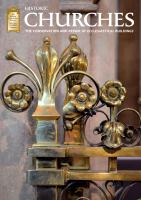

38
BCD SPECIAL REPORT ON
HISTORIC CHURCHES
22
ND ANNUAL EDITION
VANDALISM
Although inadvertent vandalism due
to ill-advised arboricultural practice
has been distressingly common in the
past, thankfully deliberate vandalism is
quite rare. Recent cases include a well-
documented ancient yew at St Mary’s
Church in Iffley, Oxon which has a
good claim to being contemporary with
the original Norman church. This tree
was completely stripped of the bark
on a major limb by local youths with
nothing better to do. The only course
in this instance is to remove the limb,
which cannot recover without bark,
and to instruct the local youths.
At St Mary’s Church in Linton,
Herefordshire a fire was set inside the
hollow of the vast and venerable yew.
Despite the ferocity of the blaze as the
inner wood burned, the tree narrowly
survived and now flourishes again,
another cautionary tale regarding the
inadvisability of removing damaged or
declining yews.
Nothing can stop vandals if they are
absolutely bent on destruction, but some
things can be done to reduce the risk of
this kind of damage. Twiggy lower trunk
growths are sharp and uninviting, mildly
dangerous and often removed to show
the shape of the trunk, but they do work
rather well as an anti-vandal ‘coating’, so
where the risk of vandal damage is present
keeping such twigs should be considered.
The churchyard of St George’s
Church in Crowhurst, Sussex boasts one
with salts over the active rooting area,
chopping the top of the tree off and
hoping it will regenerate… the list goes on.
Suffice it to say that humans with
poisons, chainsaws and plastics in
the recent past have represented the
biggest threat to these trees, some of
which have effectively looked after
themselves since they were planted by
Saxon or sometimes even older hands.
Work should never be undertaken on
an old yew without expert advice.
THE TOTTERIDGE YEW
At St Andrew’s Church in Totteridge
stands a very old ‘consecration yew’
of Saxon provenance, with a broad,
dead-looking trunk and a small bushy
canopy. The tree has a long history and
was first measured by Sir John Cullum
in 1677 at 26 feet in girth. Re-measures
through the years yielded the same result,
which remains the same to this day.
This represents a conundrum, because a
growth stall of over 300 years should have
killed it and the outer parts of the tree are
in fact dead.
The tree survives because it is
growing inside its old trunk: a mass of
strong and convoluted internal roots
which support most of the branches.
After three centuries like that the old
trunk looks set to fall away and expose
the new core that the tree has made for
itself, except for a number of narrow
runs of new vigorous wood which have
inexplicably managed to grow up the
old trunk surface like woody rivers.
The work of the churchwardens and
others associated with the churchyard
has been exemplary, the tree has been
suitably mulched to try to invigorate it
and nothing has been cut off it. It has
been able to regenerate in a fashion that
no-one could have predicted; an excellent
intervention for a temporarily somewhat
parlous Saxon yew, which has worked
very well. This incredible treasure was
spared removal and is responding to
gentle encouragement.
Further Information
The Ancient Yew Group
www.ancient-yew.orgTOBY HINDSON
is a working horticulturist
also engaged in long term empirical studies
of yew growth, and a founder member of the
Ancient Yew Group.
1
See Dr Charles Mynors’
‘Unauthorised Works’,
Historic Churches
2012
, Paragraph 8
(www.buildingconservation.com/articles/unauthorised-works/
unauthorised-works.htm)
PRINCIPLES OF CARE
•
Only carry out work which is clearly necessary
•
don’t let ivy grow up the tree
•
if work is needed, useful non-intrusive
interventions include weeding, fencing and
mulching
•
cutting or propping the tree must be left to
specialist qualified professionals;
British Standards (especially
BS3998:2010:
Tree work. Recommendations
) and Faculty
legislation apply
•
unauthorised works to trees covered by tree
protection orders or in churchyards which
fall within conservation areas may lead to
prosecution.
1
Plan of the ancient north yew at Long Sutton, Hampshire showing the use of props to support branches
of the oldest yews in England, probably
a pre-Christian tree. This specimen is
surrounded by an iron railing, as is the
huge yew at South Hayling in Hampshire.
Fencing is a good solution for reducing
footfall compaction of the rooting zone of
the yew and eliminating casual vandalism
but done properly it can be expensive.
IVY
Ivy is not generally a problem for yews
in the wild because the yew’s dense
canopy and surrounding vegetation tends
to shade it out. For yews managed by
humans, however, it is a different story.
Raised canopies and the clearing of
undergrowth allow more light to the base
of a yew, helping ivy to flourish.
Ivy is a stealthy killer of old yews,
once established in the canopy it will
reduce the vigour of the tree through
shading, and it can act like a sail, changing
the wind balance and weight of upright
sections which can lead to the tree being
wind-felled. Ivy may be a great habitat,
but if it is welcome in the churchyard
it should be allowed to colonise less
significant trees, not ancient yews.
ERRORS OF THE PAST
The greatest threat to historic yews
has been unenlightened management.
Damaging interventions include: felling
ancient specimens because they were
untidy or looked ‘ill’, filling hollow trunks
with everything from concrete through
foam filler to plastic bottles, weed killing
Railings have protected this very ancient yew at
Crowhurst in Sussex for over a century.
1
Section 3: living
fallen branch/section
Sections 2, 4
&
5: trunk and
associated branches supported
Section 6: timber lost in
1999/2000
Section 1: dead, too low to prop –
will eventually be lost entirely
Prop
Prop
Prop
North
3
2 1
4
5
6
















